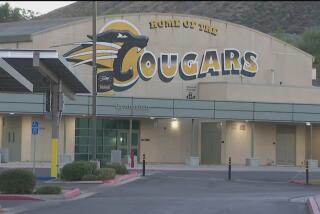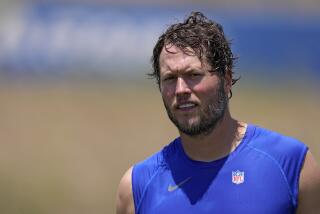The Casualties of a Summertime Tradition
- Share via
The heat wave was supposed to have broken, but the thermometer said 95 degrees. From the far end of the practice field, the vista was as it had been for decades, for generations. Emerald grass. A shimmying curtain of rising heat. A chain-link fence, and against it, boys massing in school-issue T-shirts and shorts. Smells of sweat, smog, asphalt, cut grass. The clank of free weights. The high school football team was doing summer workouts. Ninety-five degrees.
My husband, a native Southern Californian, says it has been ever thus, here in this reconstituted desert, except that the pain and gain that once waited until August are now summer-long. Kids on blast-furnace-hot practice fields sprint, as he once did, until the sweat splashes from their bodies. They stop afterward at the same drive-thru dairies to chug half-gallons of the same icy fruit punch.
And for all the advances in sports medicine, the cultural attitude toward heat has refused to budge one iota. The doctors preach, the coaches bring water, but the kids still come home with the same I-ran-till-I-vomited tales. Last September, one of our kids’ friends, a water polo player, worked himself in triple-digit heat with a 30-pound weight belt until he sank to the bottom of the pool in delirium and had to be pulled out by his coach.
A doctor in the Inland Empire told me the other day about a kid who collapsed three or four Augusts ago in the school parking lot after practice. Heat exhaustion. The boy was in intensive care for a week. The case never made the papers, but if it had, it surely would have been dismissed as a freak occurrence. After all, for decades, for generations, kids’ sports have been this way.
*
This tradition sits, shimmying like a hell-week heat wave, in the backdrop of an item that came out of Upland last week. Last Monday at 4 p.m., during a preseason conditioning class for fall sports at Upland High School in 100-plus degree weather, a 15-year-old boy named Chris Hartzog went into cardiac arrest and died.
By all accounts, the coaches were driving the kids no harder than kids had ever been driven in Upland in summer. Indeed, the number of wind sprints they were doing had been cut back due to the heat. Everyone was drinking water, everyone had drenched their T-shirts, no one was wearing pads or rubber suits. The coaches knew CPR. The boy--a big kid, 5 feet 10 and 207 pounds, going out for JV football--was revived twice, by their own frantic ministrations, only to die in the emergency room.
“When we got there,” the boy’s grandmother, Edwyna Williams, said, “‘my daughter met us and said ‘He’s gone.’ I didn’t understand at first. I said, ‘Gone where?’ ”
Williams, a data entry operator from Pomona, remembers rushing into the hospital, her heart racing. “They took us in to see the body. I had my Bible with me, and we just sat there and read Scripture, the 23rd Psalm.”
Later, the coroner would determine that Chris, who had moved to the suburb six months before from Mississippi, had a congenital heart ailment that had gone undetected because the school-sponsored program didn’t require physicals. Not that a physical would have necessarily mattered: Williams said the boy had had the usual medical attention throughout his childhood, with no word of any heart problem. “As far as we knew,” she said, “this was a healthy kid.
“I’m not going to single out that school,” Williams said sadly. “Or the coaches either. Because this goes on all over. It’s gone on for years. This has been a tradition, with the heat and these physicals that are no more than a doctor snapping his fingers. Perhaps it’s time for a change.”
*
In the multitude of childhood perils--guns, alcohol, car crashes--heat is undeniably a lesser risk. Still, between 1995 and 1997 in the U.S., according to the Institute for Preventative Sports Medicine in Ann Arbor, Mich., heat-related injuries in football alone killed seven student athletes. Locally, a UCI soccer player and a boy on the San Fernando High School football team died of heatstroke while training in 1992.
Did heat contribute to Chris Hartzog’s death? The jury’s still out. The coroner says his body temperature wasn’t taken in time for it to offer the usual clues. But even unsettled, the incident raises other questions: If a game can be called for rain, why should anyone of any age tough out a heat wave, which can be at least equally dangerous?
Sports are great. But have you ever noticed how many sports “traditions” involving children turn out to be ordeals that adults would sue over, were they on the receiving end? Decades have passed, and generations. Isn’t it time to come in out of the noonday sun?
*
Shawn Hubler’s column runs Mondays and Thursdays. Her e-mail address is shawn.hubler@latimes.com
More to Read
Go beyond the scoreboard
Get the latest on L.A.'s teams in the daily Sports Report newsletter.
You may occasionally receive promotional content from the Los Angeles Times.










